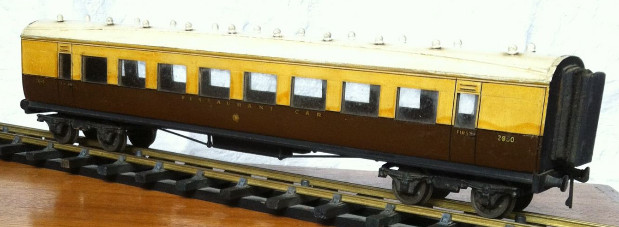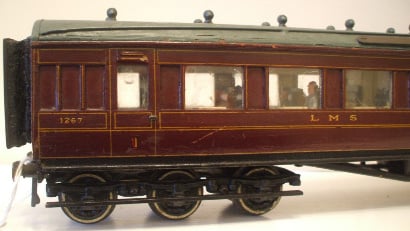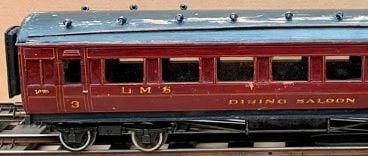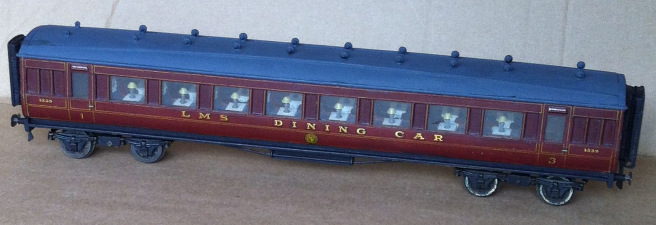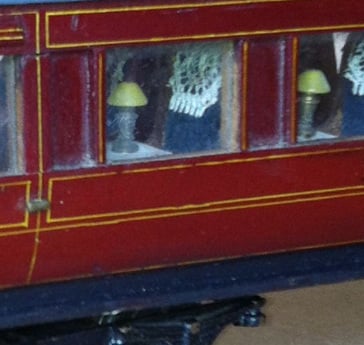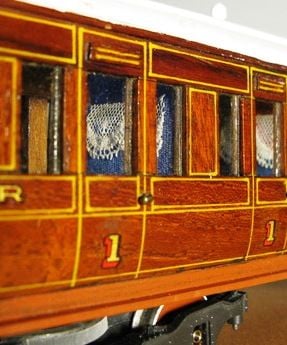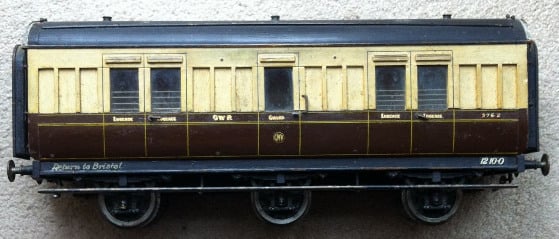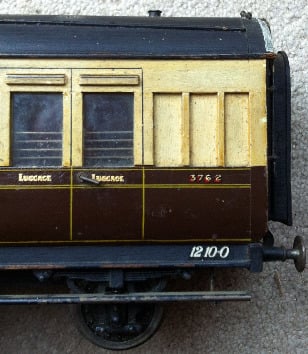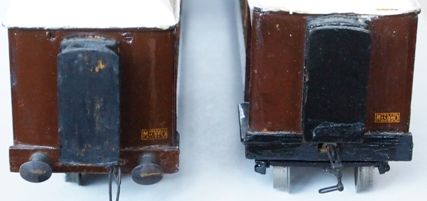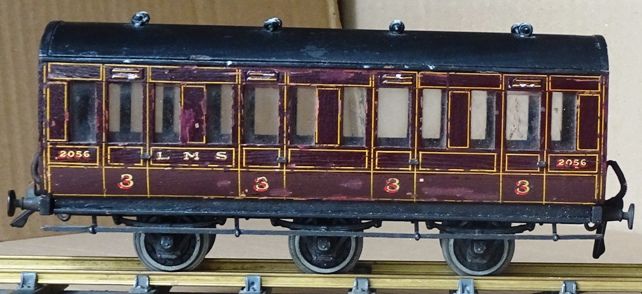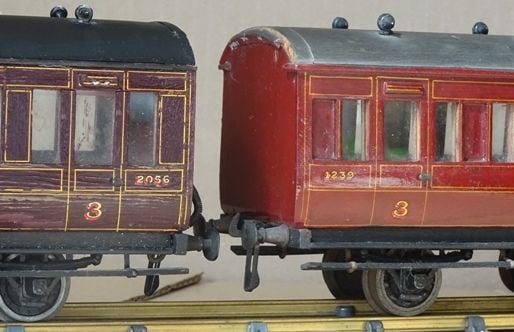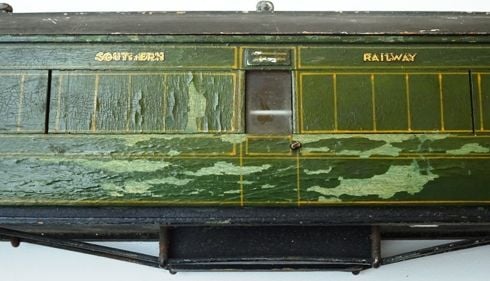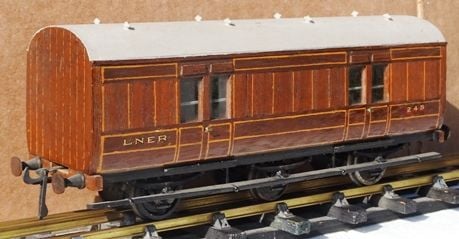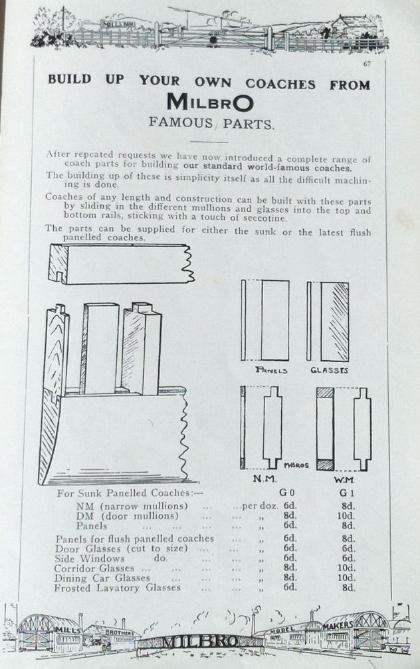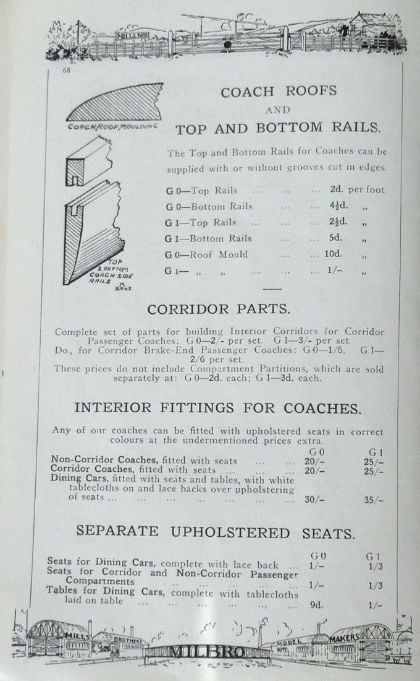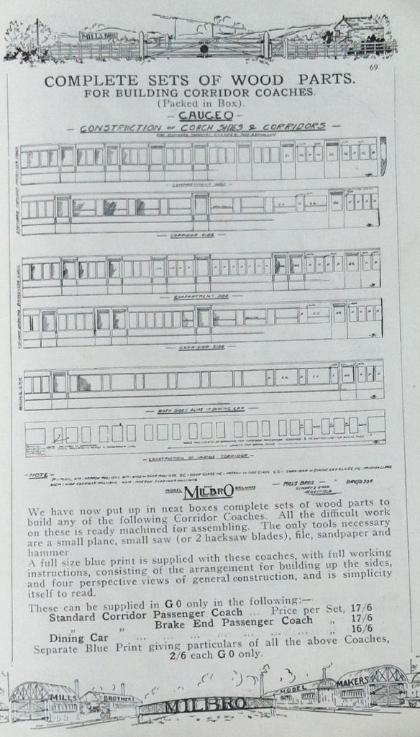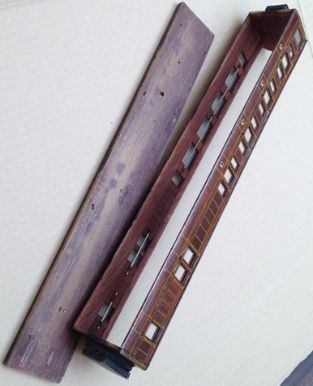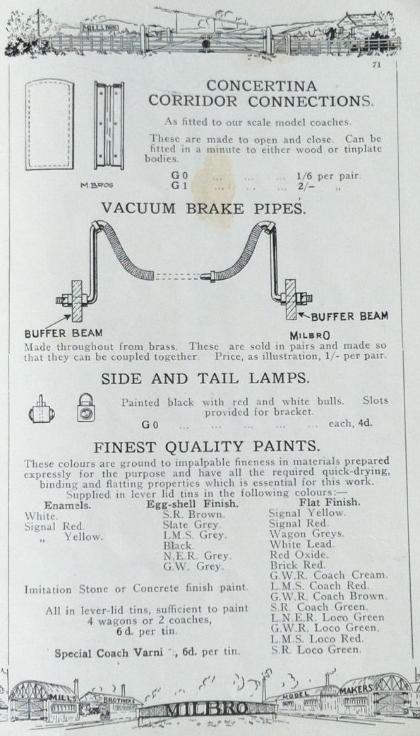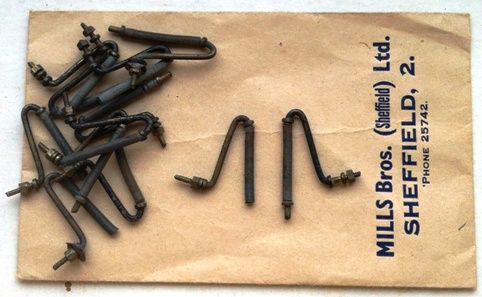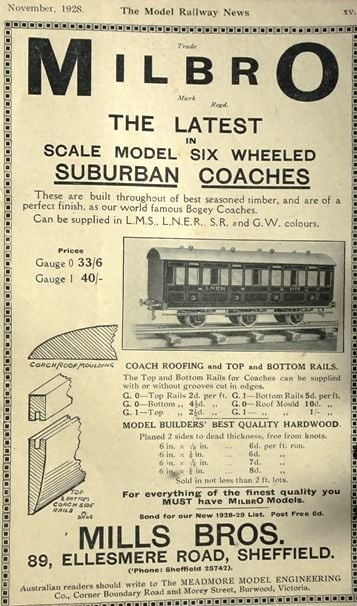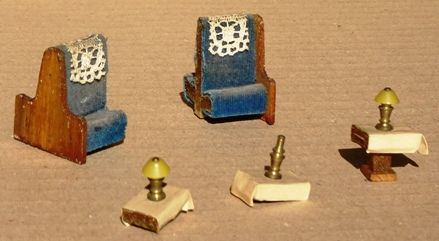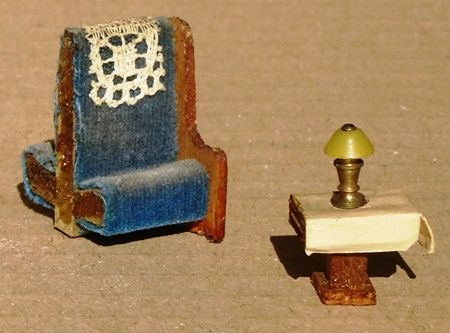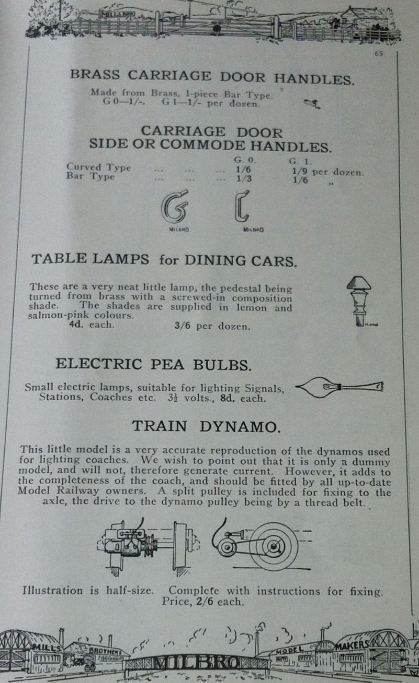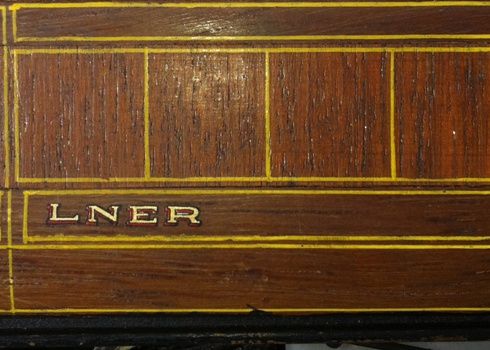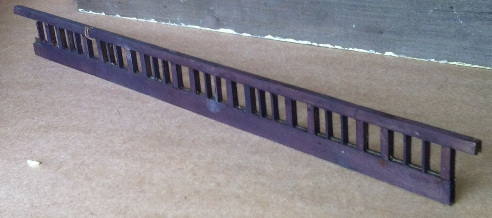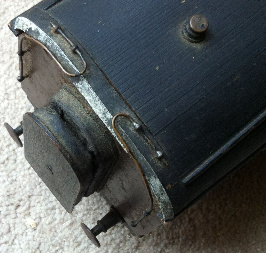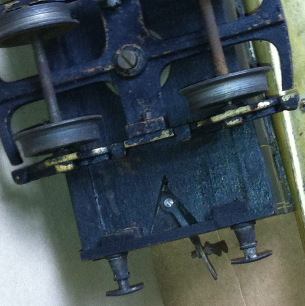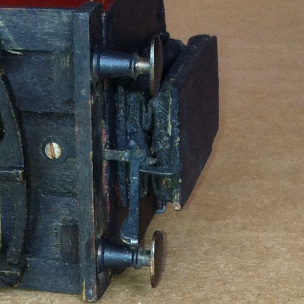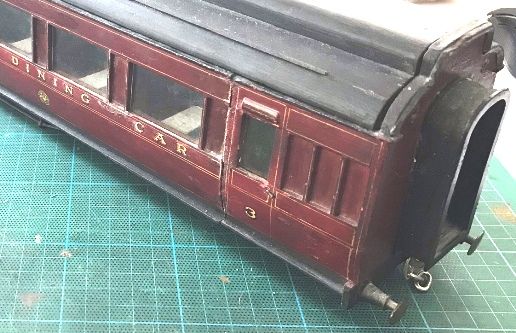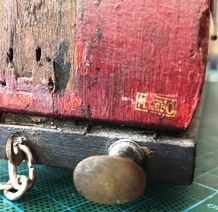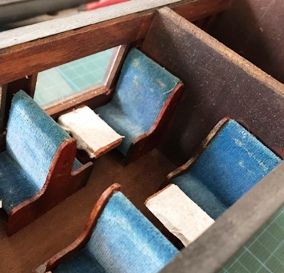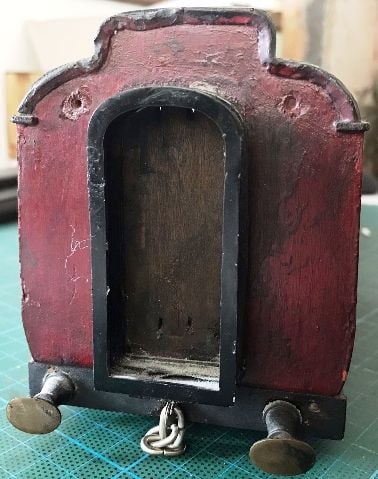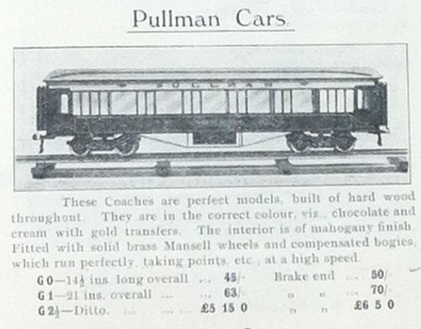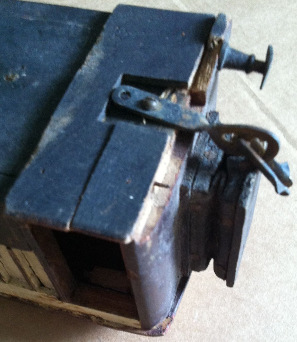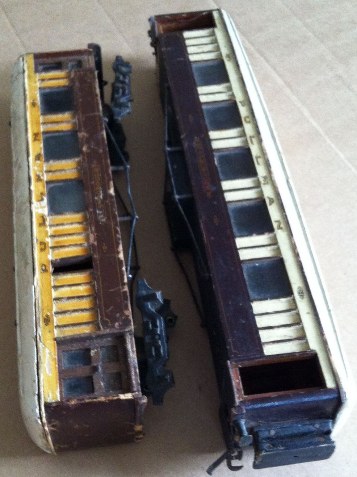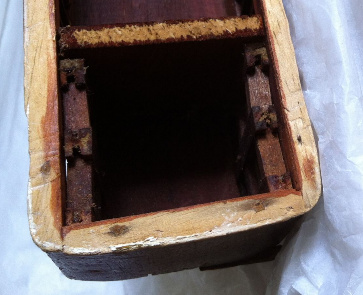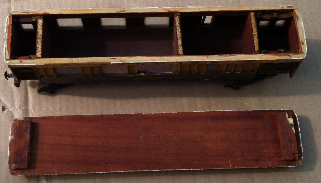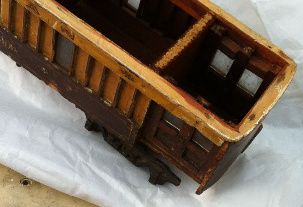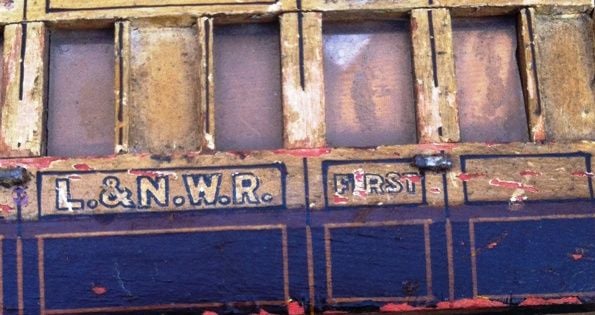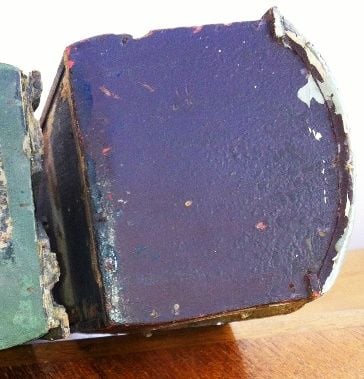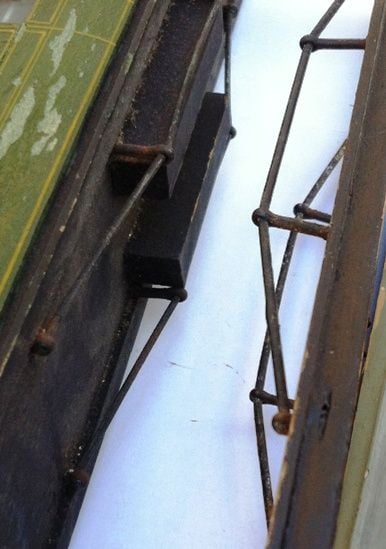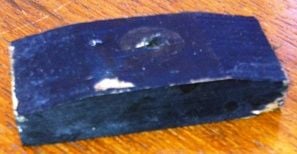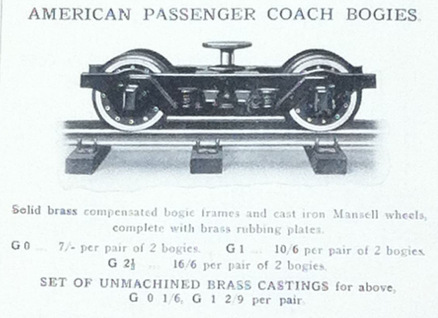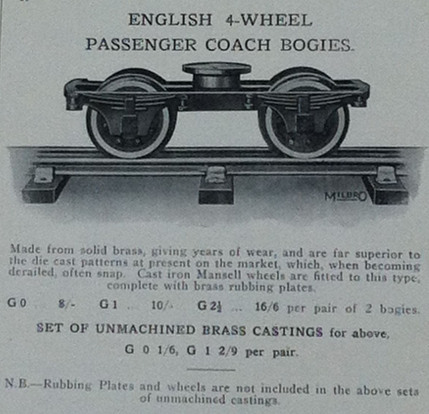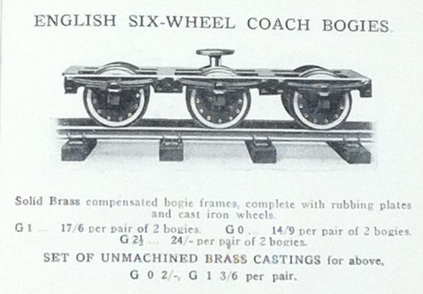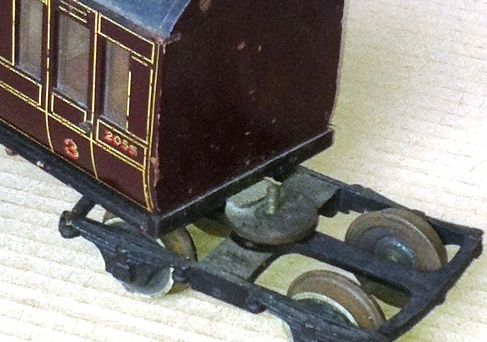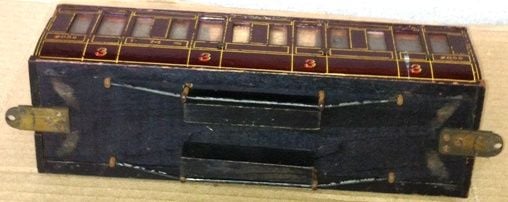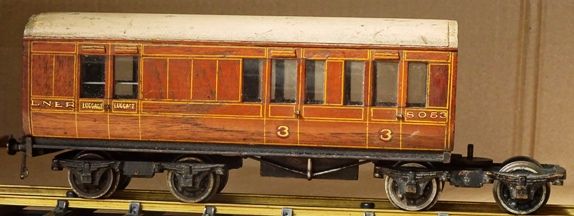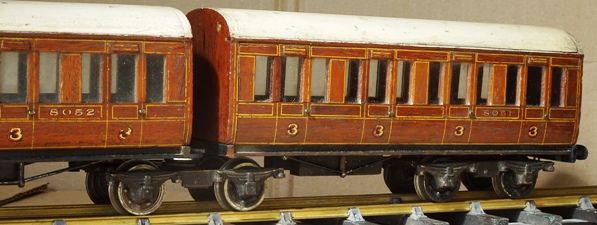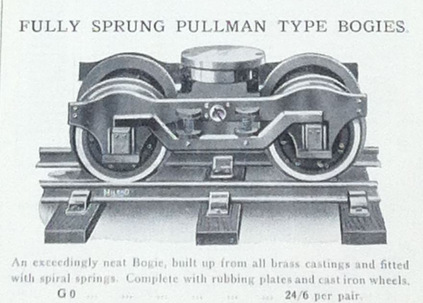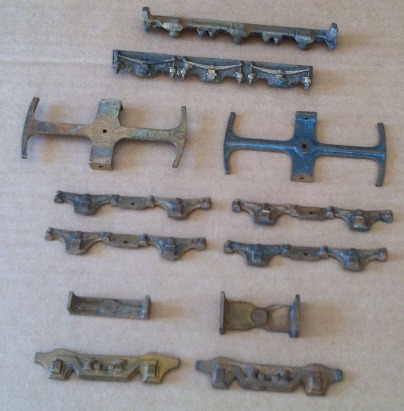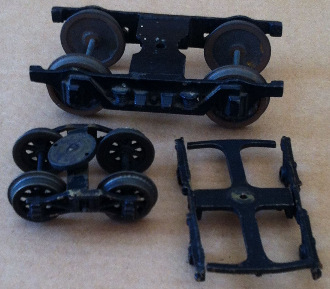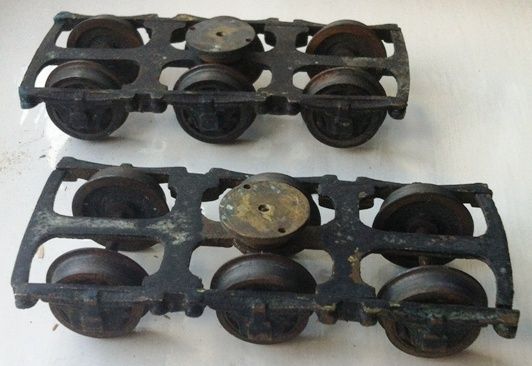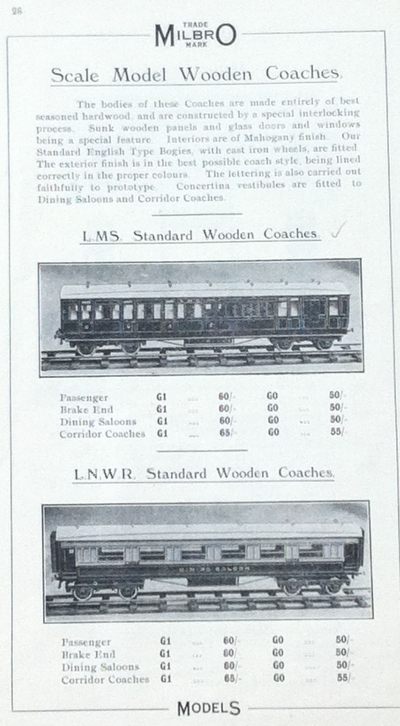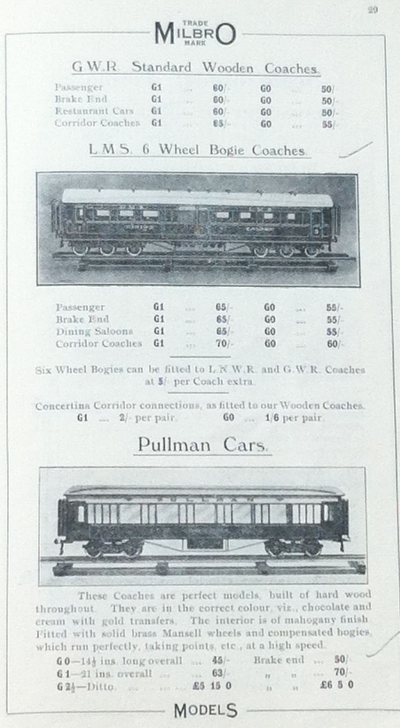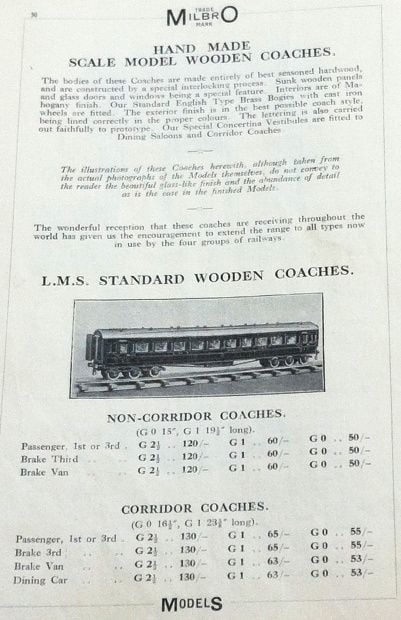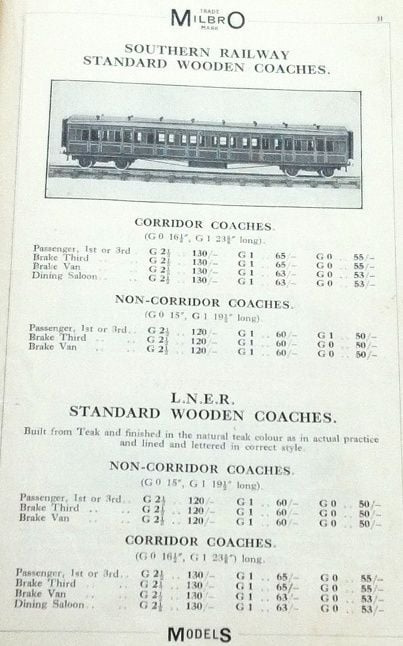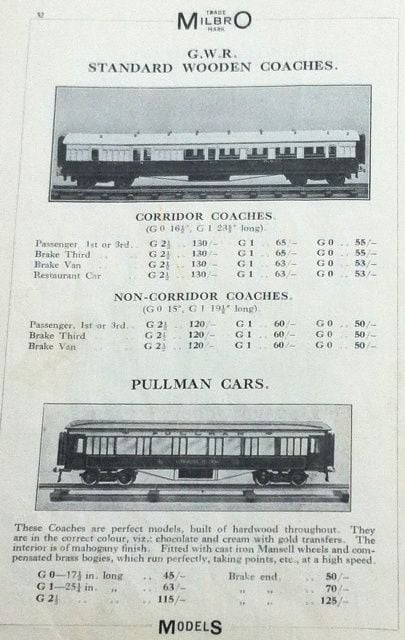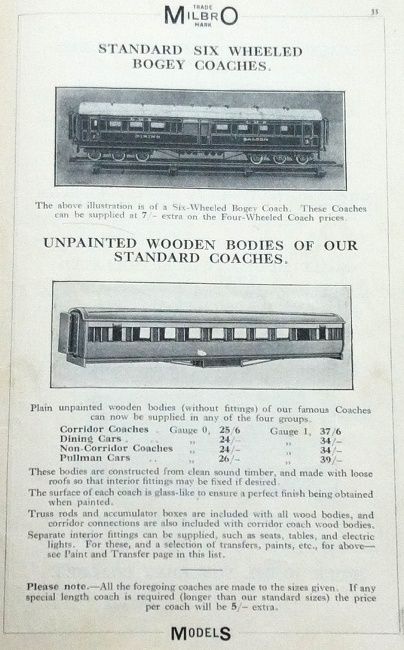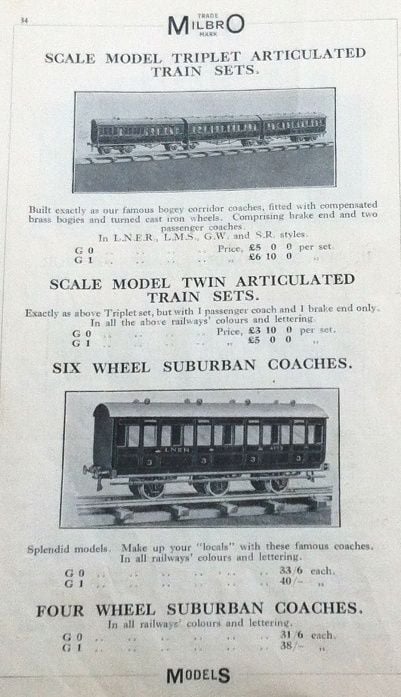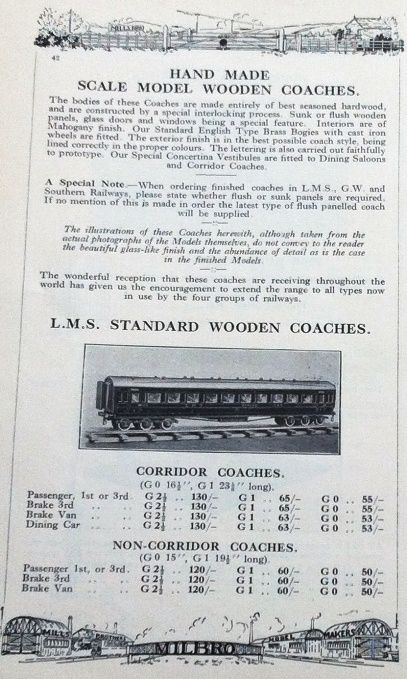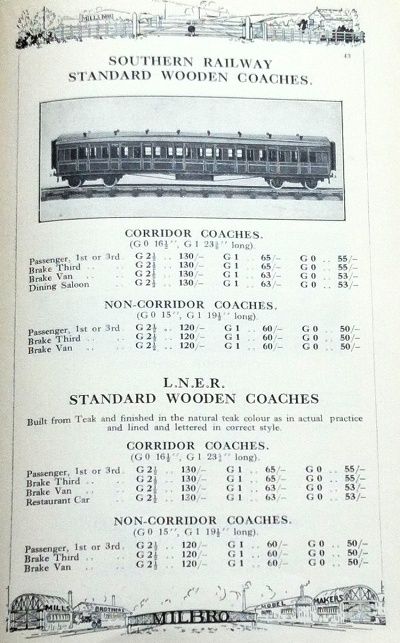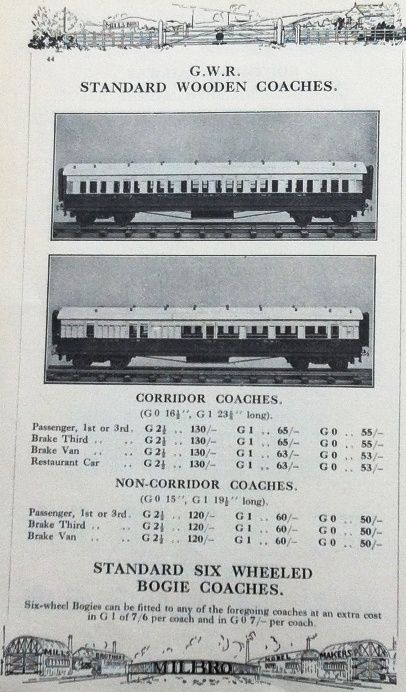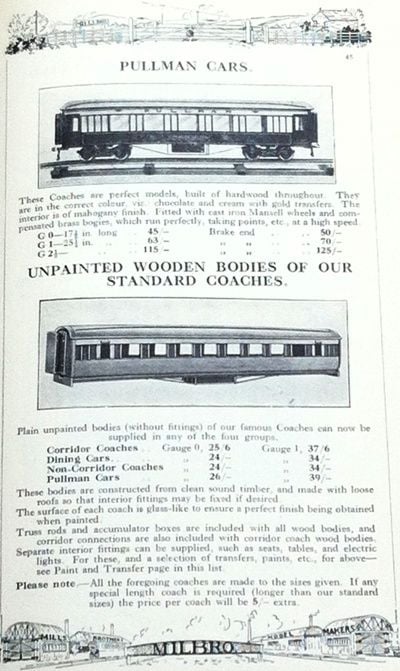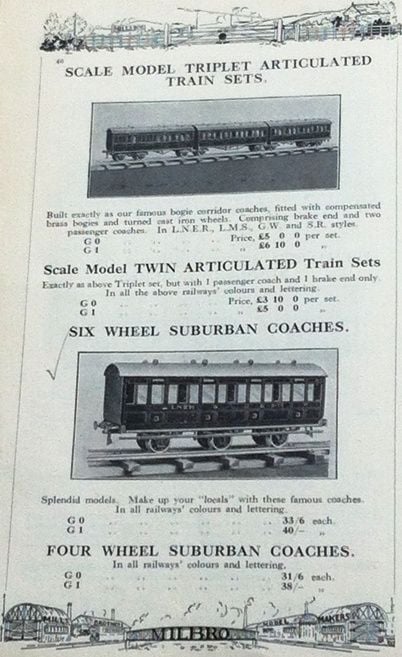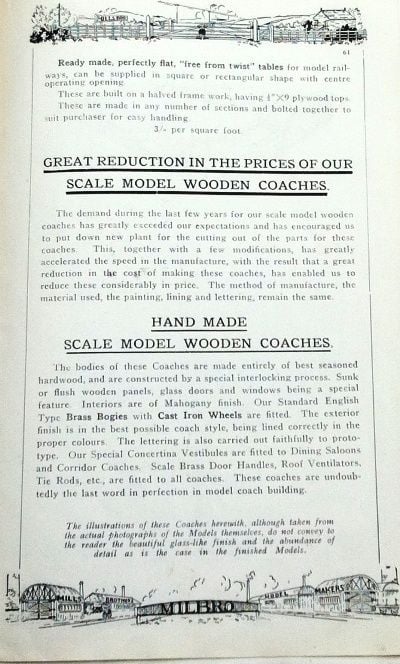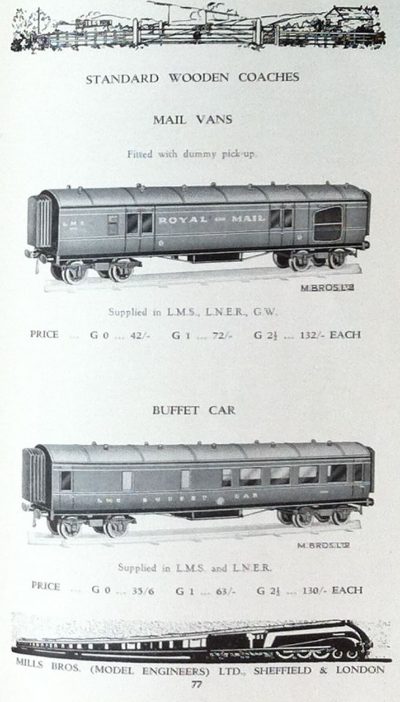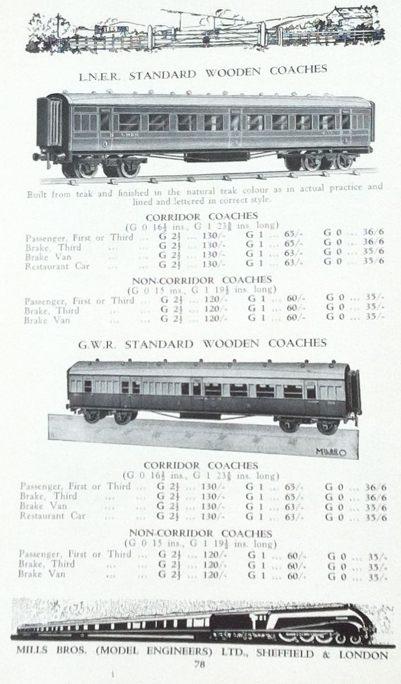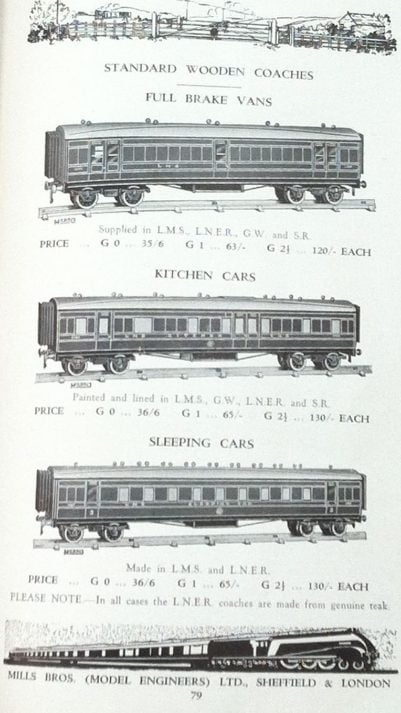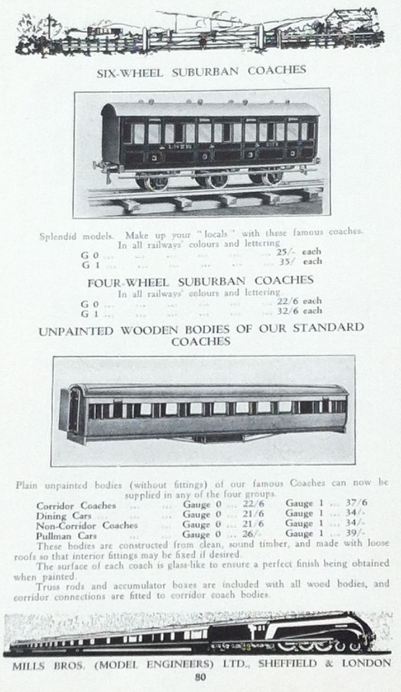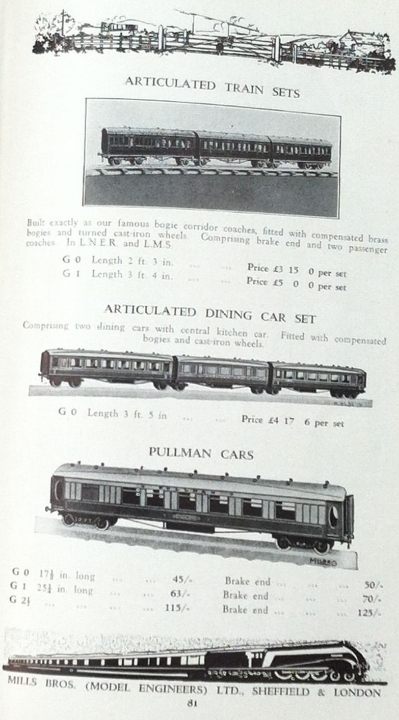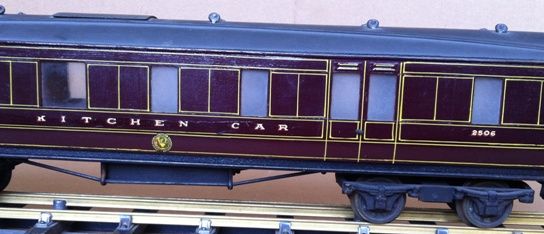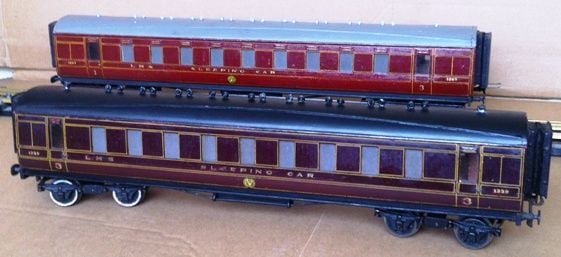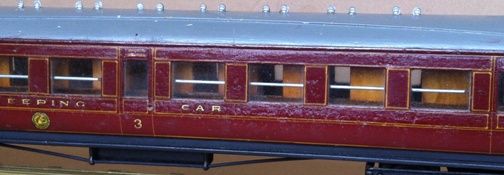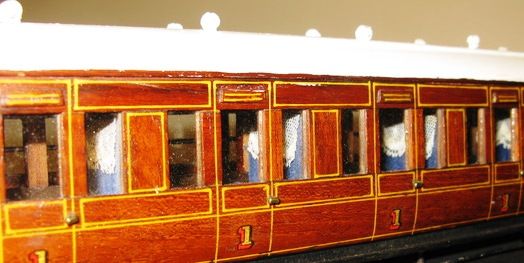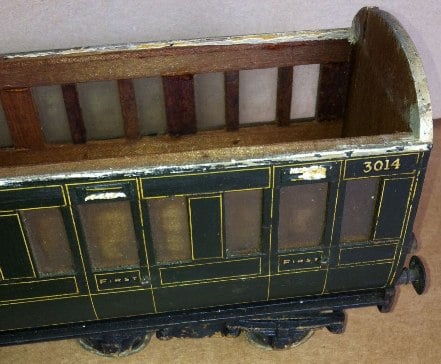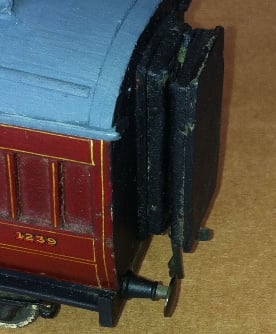
Milbro Coaches
*This section was most recently updated in June 2024*
Milbro coaches and similar vehicles
Copyright is retained by M.L.Harrison for all text and photos, except for those taken by other owners and enthusiasts.
M.L.Harrison 2020 © All rights reserved.
This section provides some general information on Mills coach construction and characteristics, and includes catalogue extracts and photographs that illustrate (selectively) what was available from the factory. Photographs are of 0 gauge items, except where specifically identified as being of a Gauge One model. For purposes of comparison, and to supplement information available elsewhere from other writers, we comment briefly in another section of this website on some features of coaches offered by Milbro's competitors and successors, and hope to enlarge material gradually on this (with Bond's, Douglass, R Models, Exley, Jubb, Leeds, W & H, etc.). In the post-war decades CCW adopted building practices that to some degree borrowed from what Milbro had done in the 1920s and 1930s. When time allows, some comments might be added on CCW vehicles at the end of the present section. For the moment, there is simply a brief note on roof characteristics. It seems that the Milbro approach to coach construction may have been linked with design and development work by Henry Greenly, who had a relationship with Mills, and for a while with the firm Jubb. In our website section on Coaches by Other Makers, we include some material from Jubb that shows the construction system that Greenly created.
Some opening examples from the Milbro coaches range Illustration C1 Milbro GWR restaurant car. This vehicle provides an example of a coach that has "flush panelled" sides rather than having sunken/recessed panels.
Illustration C2a. Mills 6-wheel bogie, attached to a Milbro LMS dining car. A modeller has added the steps/footboards and passengers. Although complete 6-wheel bogies and unfinished castings may be found occasionally (see below for pictures), relatively few coaches seem to have been sold as twelve-wheelers. The bogies appear to have been first catalogued quite early on, and at that time the firm offered four types of coach with these bogies, both in 0 Gauge and Gauge One. An accompanying catalogue illustration showed a twelve-wheeled 'Dining Saloon'. Many thanks to the owner of the above coach for sending me this photograph.
Illustration C2b. The title 'Dining Saloon' used on Milbro LNWR coaches and early LMS coaches seems to have been replaced at some point by the label 'Dining Car'. I think the LMS version with the earlier titling is uncommon, but we are able to show an example above. Thanks to the owner for letting me have this image.
Illustrations C3a and C3b. Another LMS diner for Gauge 0. Although the roof has been repainted, this model is in excellent condition. Like the vehicle above it shows some of the standard features associated with Milbro coaches. These include a nice paint finish, sides assembled from Mills coach parts, individual glass window panes fitted into slots (running above and below the windows), heavy iron wheels in brass bogies, and distinctive 'representational' door handles. The panels on this coach are of the 'sunken' type. Interior detail (as seen here) was added by the firm to some vehicles, but many did not have this. There is another picture of this coach in the Introduction section of this site (see Illustration 5).
Illustration C3c. Similar seats can be seen here in an LNER coach. I am grateful to the owner of this vehicle for providing me with the photo, and for another of the same coach that appears later. I have never had a very large collection of Milbro coaches, and this provides a useful example of one with interior details that is not a restaurant car. I think only a minority of the ordinary corridor coaches or suburban ones were detailed in this way. This particular coach has been expertly restored, and fitted with modern bogies suitable for LNER.
Illustrations C4a and C4b. LNER coaches. There is some variation in the colouring of the teak coaches that Milbro made, although the darkness of a vehicle may be intensified by its having been given a relatively recent coat of varnish by a previous owner! The first vehicle above is a sleeping car which had lost its lettering when it came to me. I have re-lettered it with vintage transfers, and will show another picture of it later in this section. The sleeping car lettering on this model is placed where the LNER seems to have placed it, but Mills might have put it higher. Another LNER sleeper was auctioned by Special Auction Services in 2020, and differed from the one shown now. My guess is that coaches varied quite a lot over time, especially if they were the less common types. The finish on the restaurant car is very smooth and bright (and it seems to have reflected the light a little for my photo). When the insides of coaches are examined, some LNER ones are found to be made from relatively dark teak.
Illustrations C5a and C5b. Gauge One GWR six-wheeler (also shown in the Introduction section of this website and in Illustration C15 below). A previous owner gave this model some replacement plastic ventilators on the roof; these have been removed and it now has some soft metal ones. Its present owner runs a vintage Gauge One garden railway.
Illustration C6. An 'end view' of two Mills pullman coaches, showing standard trade marks. Thanks to the owner of these vehicles for this picture. Milbro Pullman coach bodies had ends that were made in a distinctive (or 'non-standard') way. See also Illustrations C17a-C17d below.
Illustrations C7a and C7b. The first picture here shows an LMS example of a Gauge 0 6-wheeler. It looks to have had plenty of use, but is still in fairly good shape. The variation in Mills LMS colours is illustrated in the second picture. There also seem to be variations in coach lengths for six-wheelers, although one distressed example I have looks as if it might have started out as a four-wheeler.
Illustrations C7c and C7d. Two Milbro Southern full brake coaches are shown here to illustrate the effects of long use, and what lies beneath the paint. The first vehicle has had some damage to its finish, but this is relatively minor (and thanks are due to its owner for sending me this photograph). In contrast, on the coach in the lower picture (which isn't quite as brightly coloured as my photo suggests!) the main paint layer has worn off in patches, revealing a different green underneath. This might be some kind of undercoat, but perhaps it may have been created by Milbro using a wood stain. The same kind of treatment seems to have been given by Milbro to the LMS 6-wheeler above in Illustration C7a. Some wagons also seem to have been prepared this way before painting.
Illustrations C7h and C7i. This is probably a very good kit-built model or one assembled by drawing on Milbro spares, rather than a special order item from the factory. I include it here to show how well an enthusiast (or another professional maker) could capture the Milbro style while building a vehicle that was not in the Mills Brothers catalogued range. If I am wrong and it was made by the Mills factory, then it was probably restored or altered later by the person who put a date underneath in pencil (as seen in the second photo). Whatever its history, it makes a nice addition to the more standard 6-wheelers above. There is another photograph of it on our Home page.
Illustration C7j. This coach is part of a breakdown train, and the complete three-piece set can be seen in our website section on wagons by other makers. The current paintwork and the detailing below the body were most likely later alterations to a fairly early Milbro factory 6-wheel model.
Illustration C7k. A nice GWR version of the Mills 4-wheeler. Thanks to the owner who sent me this picture. I have seen relatively few of these shorter vehicles, and don't have a proper sample from which to be certain about length. No doubt a 4-wheel version has sometimes been created simply by leaving out the centre wheels.
Components, parts and construction In the company's earlier years there was mention in the catalogue of "scale model tinplate passenger rolling stock" (for MR, LNW and GN), with tinplate bodies, solid brass wheels, and "bogie frames, fixed on wooden bogie stretchers". Buffer beams were of wood. This seems to have been a cheaper line of products than the wooden coaches for which the company became well known, and mention of these tinplate models disappeared fairly quickly. I have never so far seen anything that fits their description. As far as I can tell from the limited information I have, it seems that the wooden coaches were initially just advertised as finished products. They included not only standard coaches with 4-wheel bogies, but also some 12-wheeled vehicles and Pullman cars. Before long, however, coaches were available in three forms: complete from the company or via another retailer (fully finished and fitted with bogies, etc.); as unpainted bodies; or as kits. Parts could also be purchased as separate items. Amongst its range, the firm was offering some articulated sets of two or three coaches, and both six- and four-wheel short coaches alongside the larger vehicles. Enthusiasts have tended to admire the LNER coaches in particular, perhaps because the company built these "from Teak" and finished them "in the natural teak colour as in actual practice". The quality of wood used for coaches in general seems to have been high. Catalogues through the 1930s showed the approach to construction, with standardisation of wooden and other components. As the firm's texts and pictures explained, coach sides were built up by sliding small panels and "the different mullions and glasses" into slots within upper and lower sections of the wooden sides (see diagrams immediately below). Panels could be for flush panelled coaches or for "sunk panelled" ones (although in the earliest period reference was simply to "sunk wooden panels"). The coaches produced in this way were relatively robust, despite glass being included. Perhaps the method was especially convincing for Gauge One items (such as the GWR 6-wheeler shown above).
(The original floor has been removed because of unsightly and extensive damage to this coach by a previous owner. I have taken the one shown from a dismantled kit-built coach as a replacement. The floor has two layers of wood.)
(A packet with some vacuum brake pipes.)
(Advertisement from The Model Railway News, November 1928, 4, 47, page xv.) (Note the reference at the foot to the Australian company, Meadmore Model Engineering in Victoria. We mention this firm again in our section about Other Vintage Locos and Motors. )
('Furniture' from the interior of a Mills restaurant car. These items were removed because only a small minority of the original components remained when I obtained the vehicle. The table lamps were described in the catalogues (see below), and were carefully made. The seats are of wood, with added fabrics, and the tables are three pieces of wood covered in paper. Glue held things in place, apart from the lamps. The shades seem to be of the 'lemon' variety.)
Illustrations C12a-C12h. Catalogue pages showing some of the main materials sold by the company for the construction, detailing and painting of coach bodies, together with a picture of a coach body with its floor removed, a photo of vacuum brake pipes as sold by Milbro, an advertisement from 1928, and some items from a coach interior. The dynamo on the bottom page may perhaps have been supplied from LMC, and the "carriage door side or commode handles" shown are not usually seen on the 0 gauge coaches. As far as I can tell, the vacuum brake pipes were also not usually added by the factory, although no doubt this would be done if requested. Milbro's standard practice for coach door handles in O gauge seems to have been to use compressed split pins.
Illustration C12i This close-up shows the vertical direction of the wood grain in panels on the side of a standard Milbro LNER coach, contrasting with the direction in the horizontal sections above and below the panels.
Illustration C13 Typical Mills coach construction. Factory-built coaches often have one or more flat rectangular reinforcing pieces of wood joining the tops of the two sides just below the roof section (or more rarely fixed to the underside of the roof and acting as a 'spacer' for the sides). This can be seen here in a Southern suburban vehicle. The patches of white colour showing intermittently along the upper part of the coach side (above windows) result from deterioration of the embossed silvered card 'louvres' (see also Illustration C40). This coach has no internal details.
Illustrations C14a, C14b and C14c The upper two pictures show a GWR coach with interior detail that includes wooden partitions. The lower illustration contains an example of the partitions designed to run length-ways inside coaches, and made up of standard parts in the same way as a coach side (albeit without glass here).
Illustration C15 Some factory-made coaches have a piece of lead fitted at each end of the roof, as seen here on the Gauge One GWR six-wheeeler shown earlier.
Coaches made in the factory tend to have a section cut out underneath the vehicle at each end to accommodate the couplings. A triangular or rectangular piece of wood was removed from the lowest layer of the floor, as can be seen below (although I do not think this necessarily applied in some very early wooden coaches). Small wooden blocks might also be positioned behind the buffer beam opposite each buffer (although these may have been lost with the passage of time).
Illustrations C16a and C16b. Two examples of details underneath the coach ends on factory-produced models.
Standard coaches were given "Truss rods and accumulator boxes", but these were of very simple construction. The accumulator boxes were made from plain pieces of wood (coloured black), and the rods were similar to those underneath bogie wagons. Thus, pieces of bent wire passed through (and were held by) split pins fixed into the underside of each vehicle. The style can be seen below in the Pullman catalogue picture photograph, and in the picture of two Pullman car sides (Illustrations C17a and C17c below). This did not apply to four- or six-wheelers. Roofs on standard coaches (leaving aside Pullmans) are generally as seen in the various illustrations above, but an enthusiast has sent me some pictures of an authentic Milbro factory-built coach that has a clerestory design. It is for Gauge One, and is the only example I have encountered. At the time the photographs below were taken, this vehicle (previously heavily damaged) was under repair (and we feature an additional 'workshop' image of it on our Home page).
Illustrations C16c-C16g. Some 'workshop' images of a Gauge One coach, which was then under repair. At time of writing this is the only example I have seen of this type of roof design on a Mills coach. Many thanks to the enthusiast who sent me these photos.
The construction of Pullmans differed in some ways from the standard coaches, with roofs and body-work being distinctive. The earlier Milbro Pullman coaches appear to have been shorter (only fourteen and a half inches long) and less realistic than the later ones. It seems likely that a very limited range of names was normally used into and right through the 1930s, and these were also available as transfers in Gauges 0 and One: Bessborough, Grosvenor, and Princess Helen (along with transfers for "Pullman", and "Scrolls for Pullman Cars").
Illustrations C17a, C17b, C17c and C17d Catalogue picture and photos of construction features of early (short) Pullman cars for 0 Gauge. The two Pullmans shown on their sides in the third picture above (C17c) are early Milbro vehicles that have been damaged and are awaiting repairs. The second picture (C17b) is of the underneath of the longer vehicle, from which the door and part of the buffer beam are missing, and where the wood is cracked. The lower picture (C17d) is of the end of the shorter vehicle seen from above.
Illustrations C17e and C17f Two more pictures of the shorter vehicle shown above. It is a rare very short "brake end" (or similar) vehicle made by Mills (and it carries clear evidence of having had a 'Milbro' transfer). A Pullman "brake end" was catalogued as part of the entry for early Pullman Cars, but I would have expected that to be of the same length as the other early gauge 0 Pullmans (fourteen and a half inches), whereas this model is shorter. In the absence of any more specific information, I would guess that the vehicle illustrated here is a very early factory product, and it may perhaps be unique, but it is also possible that the first Milbro Pullman Cars produced in the 1920s were generally of this length. Early wooden Milbro coaches may have been a little different from the standard vehicles of the mid- and late-1930s, but as I have only handled a couple of pre-grouping examples I am unable to generalise safely. One might expect a slightly more bulky style for the earlier years, as was the case with early Mills wagons, and there is some evidence for that in the pictures below (see Illustrations C18a-C18d). These show a few features of a pre-grouping coach. Unfortunately the coach body has been separated from its lower parts by a previous owner (who also cut large sections off the then separated wooden 'underframe')! I have photographed the end of the LNWR coach lying on its side, with the bottom edge of a later standard Southern full brake to its left. The LNWR coach body is a little bit wider at its base than the later vehicle. For the next picture I have propped up the detached lower sections (the remains of the wooden 'underframe') and put them alongside the same standard Southern vehicle. The wooden framing from under the pre-grouping body is much more massive than on the later coach. There is additionally a photograph of one of the two shaped wooden units which carried the bogies. These confirm that the coach is an early one (and a similar use of wood components is discussed for bogie wagons in the wagons section). It can also be seen that screws have not been added to hold the coach ends on for the LNWR vehicle, even though I have never so far seen a later standard coach without them. Although it is not clear from my photo, the windows are of glass. Instead of the embossed silvered card 'louvres' noted previously, this early example has shaped wooden versions along the upper sides of the coach instead.
Illustrations C18a, C18b, C18c and C18d. There are some bulky components on the older (LNWR) coach shown here (which was partly dismantled by a previous owner). The third picture (C18c) sets the massive wooden 'underframes' section and truss rods alongside the features below the main body of a later (SR) coach.
Since taking these photos of an early coach body, I have been sent some pictures of a dining vehicle from the same production era. It is in far better condition, and illustrates very well what the early Mills passenger rolling stock looked like when operational. Like the partly dismantled coach above, this dining saloon has a bulky style, and the end of the vehicle has similarities with the one shown in Illustration C18b. Although the bogies may not be those with which the coach was first fitted, they appear functional and perhaps of vintage origin.
Illustrations C18e-C18g Many thanks to the owner of this early passenger vehicle for letting me have some photographs of it. This dining saloon has survived quite well considering its age, and shows the firm's ability to create a stylish and attractive coach even in the early days when rolling stock was less refined. I do not know for certain whether the cylinders below the body were fitted at the time it was built, but that seems likely when one looks at the early LMS diner shown in Mills catalogue illustrations (see the picture in Illustration C25b below). In any case, they seem very much in the spirit of the overall design. An additional portrait of this LNWR vehicle is included below, as Illustration C33. Coach bogies Illustration C19 The two kinds of bogies usually fitted to Mills factory-built 0 gauge coaches. The left-hand one is of the American type, and is less common (but occurs on Pullmans as well as some LNER and GWR vehicles). Both bogies are made of brass.
Illustrations C20a, C20b and C20c Catalogue pictures of the three main Milbro coach bogie types. The fittings to hold bogies to coach undersides matched those used on bogie wagons, although there were variations in exact shape (as can be seen in the illustrations here). Early coaches can also be found with pieces of wood used instead, as with early freight vehicles (see the section on Milbro wagons elsewhere on this website).
Illustrations C20d and C20e. Arrangements for constructing articulated coach sets involved adapting standard bogies as seen in these two photos of Milbro LMS 3-coach suburban set vehicles. A piece of metal projects from each end of the central coach (shown in the lower picture), and drops over a vertical bolt running up through the centre of the bogie (seen in the picture above). The bogie unit itself is held to the end of the front or rear coach by another piece of metal joining that coach below the centre of its buffer beam.
Illustrations C20f-C20h. Pictures of an LNER version of a similar articulated set. There was heavy damage to the centre coach when I acquired this set in the 1990s, and I had to rebuild the woodwork without having any Mills spare parts (and with very limited skills). I clearly never got around to replacing the missing roof ventilators (!). A small full-length picture of the set is included amongst the coach portraits later.
Illustration C21 An advertised type that was more elaborate. As far as I know, I have never so far seen this version fitted to a Mills coach, but I assume it was used for some Pullman cars when purchasers were prepared to pay extra.
In the early 1930s Mills also referred in their catalogue to the availability of fully sprung "English Passenger Coach Bogies" fitted with "built-up leaf springs". I have not seen any picture illustrating these. Castings were available for the standard coach bogie types (just as they were for freight vehicle bogies), and some examples are shown below.
Illustration C22 Brass castings for six-wheel bogie sides, parts for the standard 'English' 4-wheel bogie, and parts for the American bogie.
Illustration C23 A Gauge One American coach bogie shown alongside a standard 0 Gauge 'English' bogie and one of the 0 Gauge freight wagon bogies.
Illustration C24 Mills Six-wheel bogies for Gauge 0.
Catalogue illustrations of coaches; pictures from the early models to those of 1939/1940 I do not currently have any catalogues from the pre-grouping era, but will begin with some illustrations from what seems at least to be a catalogue from very soon after the grouping. This shows two LMS coaches, an LNWR one, and a Pullman. There is also reference to GWR standard wooden coaches. The accompanying lists of variants include 'passenger' vehicles, brake ends, dining saloons or restaurant cars, and corridor coaches, all in Gauge One as well as Gauge 0. The length given for the 0 Gauge version of the Pullman at this time was only fourteen and a half inches long, but this vehicle was offered in Gauge Two-and-a-half as well as Gauges 0 and One. A slightly later catalogue showed LMS standard wooden coaches, Southern ones, GWR ones, a longer version of the 0 gauge Pullman (although illustrated by the same picture as before), a twelve-wheel LMS dining saloon, unpainted wooden bodies, and parts and kits. There were also triplet articulated sets (as illustrated above in relation to the bogies) and two-part ones offered, along with six- and four-wheel 'suburban coaches'. Standard LNER coaches were also listed, although not yet shown. Descriptions of standard coaches now referred to corridor and non-corridor ones, and mention was made of 1st or 3rd types. Gauge two and a half items were now included for most of the standard factory-built coaches. It can be noted that these two early catalogues were issued by the company from an address at Ellesmere Road in Sheffield, whereas subsequent ones were published from St.Mary's Road, which then remained known as the firm's address for most of its existence.
Illustrations C25a and C25b Illustrations from an early catalogue, probably issued soon after the grouping. I have been informed of MR and GNR coaches as well as the LNWR ones, and there may have been others too.
Illustrations C26a-C26e Some pages from a slightly later catalogue, although still with simple 'Milbro Trade Mark' and 'Models' titling at top and bottom of the pages. The style of edging on the tops and bottoms of catalogue pages became more ornate and decorative by the end of the 1920s, but the range of coaches available in the early 1930s still remained much as before (see below, Illustrations C27a-27e). The first catalogue page below indicates that the firm now saw flush panelling as the normal type to offer, although both were available.
Illustrations C27a-C27e The pages in this catalogue now included the more decorative designs at top and bottom.
The next two page illustrations are from a catalogue produced in 1933/34. By now the firm was featuring an expanded range of scale model locomotives (and ten examples were shown).The wooden SR electric motor coach and Metropolitan electric loco were also included in this catalogue, having been introduced just a little earlier. By the early 1930s, catalogues were showing the changed (longer) version of the Pullman car (the updated model that had been introduced previously). It had oval windows in the doors. I cannot say exactly when the new illustration first appeared, but probably in 1931/32. In the same period, illustrations for the standard coaches changed, so that specific vehicles were now shown at a slight angle rather than directly 'side on'. A full range of standard coaches was available for the LMS, SR, LNER and GWR, although initially no LNER picture was included.
Illustrations C28a-C28b Pictures from a 1933/34 catalogue. The Gauge 0 Pullmans offered here were seventeen-and-a-half inches long. The firm was also advertising not only unpainted wooden bodies but also parts and kits for its regular coaches range. The section on suburban articulated sets noted that these were built "exactly as our famous bogie corridor coaches".
The electrically-powered motor vehicles mentioned above were built on similar lines to the wooden coaches. For the SR electric motor coach and the Metropolitan motor vehicle, see our website section on Locomotives. At this time the firm was advertising a range of coaches from the four railway companies, plus Pullman Cars for which the above picture of a longer vehicle was now in continued use. This had oval windows in the doors. During the second half of the 1930s there were important additions to the range illustrated. An LNER coach picture was added in 1934/1935 (and reference was made to LNER stock being built "from Teak and finished in the natural teak colour"). In 1935/36 full brakes, kitchen cars and sleeping cars also appeared, and in 1938/39 a mail van and buffet car. At the time of the last large catalogues (probably 1940) there were still pictures similar to those used in 1933/1934 for LMS, Southern and GWR standard coaches and the Pullman Cars, as well as the familiar images for the six-wheelers and the suburban articulated set. In addition, however, there were also the LNER coach illustration, an articulated dining car set, a mail van, a buffet car, a full brake, a sleeping car and a kitchen car. Unpainted bodies were available for corridor coaches, dining cars, non-corridor coaches, and Pullmans. Through the 1930s there seems to have been some ongoing standardisation, insofar as similar items might be available with different liveries, although there were some variations (for instance in numbers of panels, door positions, etc.). Nonetheless, the range of what was available and catalogued was more extensive than in the early 1920s. I believe that the factory also produced some items that were not pictured, notably some slightly shorter coaches. At the end of the 1930s the decoration at the foot of each page became a streamliner hauling an express.
Illustrations C29a -C29f Catalogue images from about 1940.
The above survey and summary from the catalogues is tentative at some points, and the account given remains subject to subsequent correction. Unfortunately, my set of catalogues is incomplete and the earlier ones are not dated. I hope I have got the main points right.
It might be useful to note that certain of the less standard catalogued items are quite scarce, and may be almost impossible to find in a specific livery.
Variants also turn up from time to time, as with LMS corridor coaches that are shorter than the standard ones. There are also known special order items, including (as I understand it) coaches for LMS and LNER streamlined trains. An exhibition/display train can be seen with an A4 pacific in a magazine report reproduced in our section on Milbro locos.
There is an obscure brief mention of a Mills O gauge plastic coach in a Railway Modeller article in September 1964, but I have not seen anything further about this (15, 167, page 239). It may well have been a Leeds bakelite vehicle.
Selected portraits of coaches from Milbro's standard ranges I hope gradually to add below more photos of selected examples from the range. To start this off, here are some pictures of three LMS items and some LNER ones from the later pre-war years.
Illustrations C30a and C30b An 0 gauge LMS kitchen car model in good order.
Illustration C31a Two 0 gauge LMS sleeping cars. The one behind is longer than the darker one in front, by around an inch-and-a-half. I do not know if the roof of either car has been repainted or refinished. Although the vehicle at the back has standard Mills fittings to retain its bogies, the latter are by Bassett-Lowke. Perhaps that coach was supplied through Bassett-Lowke.
Illustration C31b Viewing these sleepers from the other side reveals differences in the interior arrangements. The vehicle shown in our lower picture here has an interior divider/partition for the corridor which has 11 rectangular gaps in it, and includes slotted sections top and bottom. The other is much simpler, having a plain panel with three cut out door spaces. The lower vehicle has lost one of its door handles. My impression is that Milbro sleeping cars may have varied quite a lot from one to another, perhaps as a result of being made relatively infrequently to meet specific orders.
Illustration C31c This LNER sleeper is to a different design (see also the photo of its other side earlier in this section). Our example also differs somewhat from one auctioned through Special Auction Services in 2020. The one shown now has no interior detail, and it could do with some Milbro wheels. The bright sunlight for the photo has made the coach look lighter in colour than it actually is.
C32a. A full-length Mills 0 gauge LNER suburban coach.
Illustration C32b. A picture of the complete LNER suburban articulated set illustrated earlier. It is missing its soft metal roof ventilators. A four-car set was auctioned by Special Auction Services in June 2020.
Illustration C32c. Seats fitted to a Milbro LNER corridor coach. Thanks to the owner (and expert restorer) of this vehicle for our picture, and for another one of the same features that we showed earlier in this section.
By contrast with these vehicles, we now include an item from the range offered in the firm's early years. Three other pictures of this pre-grouping dining saloon were shown above (as Illustrations C18e-C18g).
Illustration C33 An early 0 gauge Dining Saloon, in LNWR livery. Thanks are due to the owner of this saloon for letting me have some photographs of it.
Returning to the 1930s, here are some Southern coaches belonging to a specific collection.
Illustrations C34a-C34e A set of informative photos of five 0 gauge Southern coaches from a specific collection. These are corridor vehicles, including two dining cars, together with a kitchen car. The latter seems to have been heavily used. It is not too difficult to do some modest renovation on coaches in this condition, but many collectors prefer to keep items in their authentic used state. This SR Kitchen Car is a very rare model, and I think it unlikely I will see another. I am grateful to the owner of these coaches - an enthusiast with expert knowledge in this territory - for taking these portraits and letting me show them here. He has also provided our next two photos (below), of Southern 0 gauge suburban vehicles; and additionally some excellent pictures of Gauge 0ne SR coaches that are included on our Gallery section of this website.
Illustrations C34f and C34g. An 0 gauge Milbro Southern Railway Third Luggage Suburban coach, and an All Third Suburban coach.
Illustration C34h. Many thanks to the enthusiast who sent me this useful portrait of a Gauge One LMS 6-wheeler. It looks in excellent condition, and shows how good the Milbro panelling system can look at this scale.
Illustrations C35a and C35b. Portraits of two excellent 0 gauge Pullman coaches, one fitted with 6-wheeled bogies. There is a photo of the ends of these two vehicles in Illustration C6 above. Thanks are due to the photographer for letting me have the three pictures. Although these Pullmans are full-length vehicles (in line with all the later catalogue illustrations), they have rectangular rather than oval windows in the doors at their ends.
Illustration C36. LMS full brake. This example has lost some of the fittings on its roof.
Distinguishing Mills factory models from kit-built ones, and from CCW coaches
Illustration C40 A close-up of the Milbro SR suburban coach shown earlier above in Illustration C13. Note the two flat wooden sections that run along the whole of the coach, one resting on top of each coach side. The one closest to the viewer can be seen to have been edged in white paint. It passes through the coach end, where a specific slot has been cut to accommodate it.
Illustration C41 The arrangement can be seen again here. We can also see the heavy corridor connection generally supplied by Milbro, and included on one of the catalogue pages above.
Illustration C42 A kit-built model or (perhaps equally likely) an altered and stripped-down factory-made one. This seems to have been primed by its previous owner but never given his preferred coat of paint and livery. The wood has some dark staining on the sides under the primer, and markings on the ends from decayed retaining screws, so originally it may have been factory built. Equally, it might have been kit-built a long time ago and was being refurbished when the project was abandoned ! Apart from a couple of small features underneath, it also conforms to what I think might be expected for a complete unpainted body supplied by Milbro, and is worth showing here for that reason. In particular it is worth noting that the feature referred to in the two pictures above is repeated in Mills style here as well.
Illustration C43 This construction contrasts with the examples in C40-42, and is sure evidence of a kit-built model. In particular, there is no slot by which the flat piece could be carried through the coach end, and that piece has been cut short to match the length of the side below it. This difference - or the complete omission of the flat piece from each side - may be one of the things to look for when determining whether a nicely-made coach is kit- or factory-built.
Illustration C45 There are close similarities between the approach to construction developed by Milbro before the war and CCW in post-war decades. One thing to examine that may help differentiate their coaches might be the roof profiles. The two on the left here are both by Milbro (although the left-hand one is from a kit), and I think the two on the right are from CCW. The right-hand example is for constructing a clerestory coach. I have never seen a Mills catalogue picture showing a vehicle with that roof design, but the Gauge One example shown earlier in this page demonstrates the factory did build them. Perhaps that was more likely to have been for larger scale coaches than in 0 gauge. Note the two screw-holes in the end of the roof from the Mills factory-made coach here (the one painted white). Two screws normally went through each thick coach end and into the roof of each standard coach (although this may not have applied to very early coaches, and Pullman roofs were different). I have sometimes found the screws badly rusted and very difficult to take out, and this can make access to the interior for purposes of repairs difficult.
.
|
